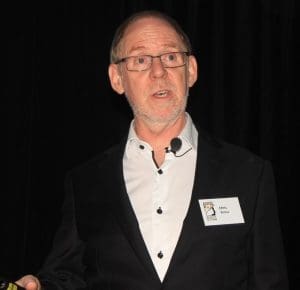 CHINA’S wool industry focus on productivity, quality and export growth rather than raw wool prices, has encouraged Australian representatives at the recent Nanjing Wool Market conference in Tongxiang.
CHINA’S wool industry focus on productivity, quality and export growth rather than raw wool prices, has encouraged Australian representatives at the recent Nanjing Wool Market conference in Tongxiang.
Despite some reported retail price resistance, record raw wool prices and lack of supply growth, Australians at the 29th annual conference have reported widespread Chinese mill confidence.
National Council of Wool Selling Brokers of Australia executive director Chris Wilcox said there had been a massive increase in woven wool clothing exports, up 180 percent from 23.6 million pieces or finished garments in the first six months in 2016, to 67.2 million pieces during the same period in 2017.
Mr Wilcox said the export growth was attributed by Madame Peng Yanli, president of the China Wool Textile Association, to China’s One Belt One Road policy. China’s ‘One Belt and One Road’ initiative is a Chinese government development strategy connecting the country with Europe via the land-based Old Silk Road route and the ocean-based Maritime Silk Road.
“That’s total exports, some of that will be going to Africa, Europe, Japan and America, but the big increase is through Africa.
“That product going to Africa won’t be staying in Africa, it will be shipped onto Europe.”
Click here to get the latest Sheep Central story links sent to your email inbox.
As well as attending the conference, Mr Wilcox said he spent five days visiting mills and he found mills were unexpectedly buoyant about the future despite current price levels.
The Chinese mills had talked about what the current Merino price levels meant for their businesses in a “very business-like mature away,” he said.
And at the conference, a number of mill owners said their focus would be on increasing productivity and product quality. Four or five years ago when prices were “highish,” the owners’ and the conference’s focus was entirely on prices, he said.
“It is a remarkable change, I must say.
“It was quite encouraging.”
However, he said some mills said there was price pressure from retail brands who were not increasing their prices in stores. At the Uniqlo store in Shanghai, Merino knitwear garments had the same price as three years ago.
“That just shows you that the retail prices aren’t moving.”
Mr Wilcox said there was also more commentary about Merino wool use in activewear, athleisure and next-to-skin type products for the domestic market and export. However, he expected there would be some movement away from Merino wool into blends or other fibres because of the record high prices, but the extent of this was not known.
Mr Wilcox expected crossbred wool prices to recover with some conference talk about increased usage of 26-38 micron fibre because prices were so low, but looking at better quality wools first.
No joy in wool supply for Chinese
Australian Council of Wool Exporters and Processors executive director Peter Morgan said Australia’s 2016-17 and projected 2017-18 wool production of around 340 million kilograms did not indicate wool growers were particularly enamoured about the price increases of the past 12 months.
Mr Morgan said the Chinese were confident that Merino prices would hold around current levels.
“They didn’t expect Merino prices to fall away.
“And some thought that crossbreds would recover, but not for a while.”
Mr Morgan said the atmosphere of the conference was positive, whereas past conferences have been focussed on price levels.
Wool prices not too high in US$
Endeavour Wool Exports principal Josh Lamb said market prices in Australian dollars to growers were expected to stay around current levels, contingent on currency movements in the short term.
“There wasn’t a lot of talk (at the Nanjing conference) from the clients I saw about US$ prices being too high as such in a general market sense.
“There wasn’t a lot of talk that these levels are ridiculous and unsustainable; there wasn’t that focus on the actual price itself, it was more about the market level for that week,” he said.
“To me that’s a bit of a shift in ideology for Chinese clients, who have always been heavily focussed on first cost – you can see things are changing a bit.”
Mr Lamb said the confidence of Chinese clients was exhibited by their reaction to price levels, using the price of the market barometer type, Type 55 — 21 micron, 1pc vegetable matter content, 33Newtons/kilotex average.
“When 21s (21 were worth US$7-$8 there was a lot more complaining about the cost of wool; there is a lot less now and that to me says the market is pretty good,” Mr Lamb said.
“It’s around about $US12.30 at the moment, but in 2011 we got up to about US$15 for 21s, obviously the currency was over parity at that stage.
“I’m not saying they are going to that level but it is still historically cheap if you look at the last 10 years.”
Fake fur has had the most impact on the market recently, but it is underpinned by the double-faced fabric from carding wools is still “bubbling along quite nicely,” he said.
“Going forward, they are talking about some new products from coarser crossbreds – that 30-34 micron range that has been in such a hole; that’s probably their next focus.”
AWI said a common theme from the Chinese delegates at the Nanjing conference centred firmly around the need for further industry programs within the education, promotion and innovation fields. In particular, it is perceived that the high prices can be maintained by continually innovating new wool products, as witnessed recently by the double faced and fake fur fabrics creating new consumers of wool, AWI said.



HAVE YOUR SAY